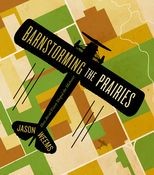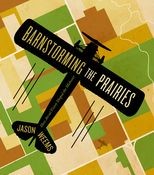Barnstorming the Prairies: How Aerial Vision Shaped the Midwest
Barnstorming the Prairies: How Aerial Vision Shaped the Midwest
Cite
Abstract
The history of the American Midwest is marked by stories of inhabitants’ struggles to envision the unbroken expanses of their home landscape. During the 1920s and 1930s these attempts to visualize the landscape intersected with another narrative—that of the airplane. After World War I, aviation gained purpose as a means of linking together the vastness of American space. It also created a new visual sensibility, opening up new vantage points from which to see the world below. This book offers the first comprehensive examination of modern aerial vision and its impact on twentieth-century American life. In particular, the project centers on visualizations of the American Midwest, a region whose undifferentiated topography and Jeffersonian gridwork of farms and small towns were pictured from the air with striking frequency during the early twentieth century. Forging a new and synthetic approach to the study of American art and visual culture, this work analyzes an array of flight-based representation that includes maps, aerial survey photography, painting, cinema, animation, and suburban architecture. The book explores the perceptual and cognitive practices of aerial vision and emphasizes their formative role in re-symbolizing the Midwestern landscape. Weems argues that the new sightlines actualized by aviation composed a new episteme of vision that enabled Americans to conceptualize the region as something other than isolated and unchanging, and to see it instead as a dynamic space where people worked to harmonize the core traditions of America’s agrarian identity with the more abstract forms of twentieth-century modernity.
-
Front Matter
-
1
Pioneering Visions: The Midwestern Grid, the Atlas, and An Aerial Imagination
-
2
Managerial Mosaics: New Deal Aerial Photography and the Marshaling of Rural America
-
3
Adaptive Aeriality: Grant Wood, the Regional Landscape, and Modernity
-
4
Jeffersonian Urbanism: Frank Lloyd Wright, Aerial Pattern, and Broadacre City
- Conclusion: Over the Rainbow
-
End Matter
Sign in
Personal account
- Sign in with email/username & password
- Get email alerts
- Save searches
- Purchase content
- Activate your purchase/trial code
Institutional access
-
Sign in through your institution
- Sign in with a library card Sign in with username/password Recommend to your librarian
Institutional account management
Sign in as administratorPurchase
Our books are available by subscription or purchase to libraries and institutions.
Purchasing information| Month: | Total Views: |
|---|---|
| December 2022 | 3 |
| December 2022 | 1 |
| May 2023 | 2 |
| September 2023 | 3 |
| September 2023 | 3 |
| September 2023 | 3 |
| September 2023 | 3 |
| September 2023 | 5 |
| September 2023 | 3 |
| September 2023 | 3 |
| September 2023 | 3 |
| September 2023 | 3 |
| September 2023 | 3 |
| September 2023 | 3 |
| September 2023 | 5 |
| September 2023 | 3 |
| November 2023 | 1 |
| November 2023 | 3 |
| April 2024 | 1 |




Get help with access
Institutional access
Access to content on Oxford Academic is often provided through institutional subscriptions and purchases. If you are a member of an institution with an active account, you may be able to access content in one of the following ways:
IP based access
Typically, access is provided across an institutional network to a range of IP addresses. This authentication occurs automatically, and it is not possible to sign out of an IP authenticated account.
Sign in through your institution
Choose this option to get remote access when outside your institution. Shibboleth/Open Athens technology is used to provide single sign-on between your institution’s website and Oxford Academic.
If your institution is not listed or you cannot sign in to your institution’s website, please contact your librarian or administrator.
Sign in with a library card
Enter your library card number to sign in. If you cannot sign in, please contact your librarian.
Society Members
Society member access to a journal is achieved in one of the following ways:
Sign in through society site
Many societies offer single sign-on between the society website and Oxford Academic. If you see ‘Sign in through society site’ in the sign in pane within a journal:
If you do not have a society account or have forgotten your username or password, please contact your society.
Sign in using a personal account
Some societies use Oxford Academic personal accounts to provide access to their members. See below.
Personal account
A personal account can be used to get email alerts, save searches, purchase content, and activate subscriptions.
Some societies use Oxford Academic personal accounts to provide access to their members.
Viewing your signed in accounts
Click the account icon in the top right to:
Signed in but can't access content
Oxford Academic is home to a wide variety of products. The institutional subscription may not cover the content that you are trying to access. If you believe you should have access to that content, please contact your librarian.
Institutional account management
For librarians and administrators, your personal account also provides access to institutional account management. Here you will find options to view and activate subscriptions, manage institutional settings and access options, access usage statistics, and more.